肯定句变否定句的基本方法
英语肯定句改为否定句、陈述句改为一般疑问句的方法和技巧
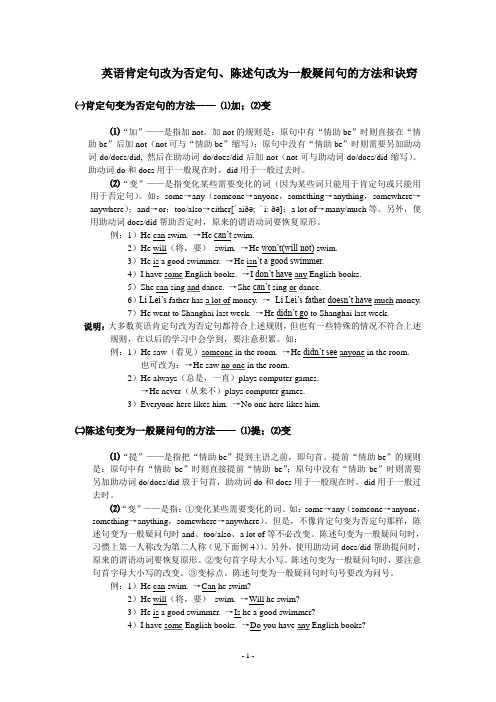
英语肯定句改为否定句、陈述句改为一般疑问句的方法和诀窍㈠肯定句变为否定句的方法——⑴加;⑵变⑴“加”——是指加not。
加not的规则是:原句中有“情助be”时则直接在“情助be”后加not(not可与“情助be”缩写);原句中没有“情助be”时则需要另加助动词do/does/did, 然后在助动词do/does/did后加not(not可与助动词do/does/did缩写)。
助动词do和does用于一般现在时,did用于一般过去时。
⑵“变”——是指变化某些需要变化的词(因为某些词只能用于肯定句或只能用用于否定句)。
如:some→any(someone→anyone,something→anything,somewhere→anywhere);and→or;too/also→either[´aiðə; ´i: ðə];a lot of→many/much等。
另外,使用助动词does/did帮助否定时,原来的谓语动词要恢复原形。
例:1)He can swim. →He can’t swim.2)He will(将,要)swim. →He won’t(will not) swim.3)He is a good swimmer. →He isn’t a good swimmer.4)I have some English books. →I don’t have any English books.5)She can sing and dance. →She can’t sing or dance.6)Li Lei’s father has a lot of money. →Li Lei’s father doesn’t have much money.7)He went to Shanghai last week. →He didn’t go to Shanghai last week.说明:大多数英语肯定句改为否定句都符合上述规则,但也有一些特殊的情况不符合上述规则,在以后的学习中会学到,要注意积累。
英语肯定句变否定句的方法

一、首先,要看肯定句中是否有情态动词,如果有情态动词,直接在情态动词后面加not即可,同时句中如果有some,some就要变成any。
举例如下:1、肯定句:Mike can help you solve the problem.译文:迈克可以帮你解决那个问题。
否定句:Mike can't help you solve the problem. (can't=can not)译文:迈克不能帮你解决那个问题。
2、肯定句:You should lend some money to Mary.译文:你应该借给玛丽一些钱。
否定句:You shouldn't lend any money to Mary. (shouldn't=should not)译文:你不应该借钱给玛丽。
二、如果肯定句中没有情态动词,那就要看句中有无be动词的相应形式,如果有,直接在be动词后面加not,句中有some,some变any。
举例如下:1、肯定句:I am an English teacher.译文:我是一名英语老师。
否定句:I‘m not an English teacher.译文:我不是一名英语老师。
2、肯定句:There are some books on the desk.译文:书桌上有一些书。
否定句:There aren't any books on the desk.译文:书桌上没有书。
三、如果肯定句中既没有情态动词,也没有be动词,那么就要用相应的助动词加上not来变换,句中有some,some变any。
举例如下:1、肯定句:She likes helping others.译文:她喜欢帮助别人。
否定句:She doesn't like helping others.译文:她不喜欢帮助别人。
2、肯定句:They have some apples.译文:他们有一些苹果。
肯定句变否定句口诀
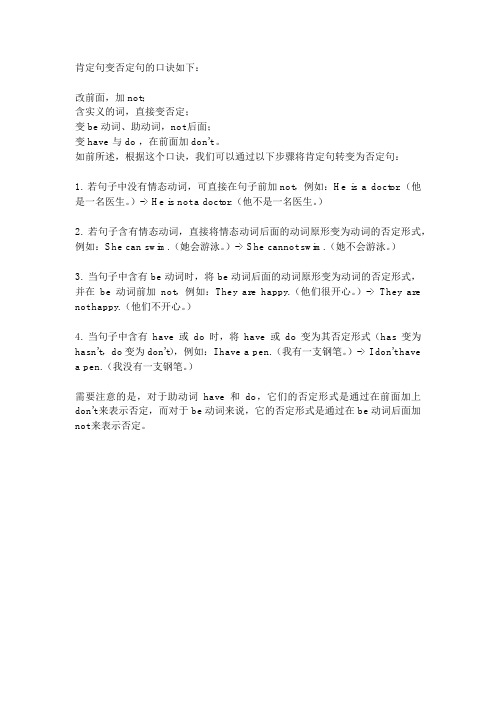
肯定句变否定句的口诀如下:
改前面,加not;
含实义的词,直接变否定;
变be动词、助动词,not后面;
变have 与 do ,在前面加don't 。
如前所述,根据这个口诀,我们可以通过以下步骤将肯定句转变为否定句:
1. 若句子中没有情态动词,可直接在句子前加not,例如:He is a doctor.(他是一名医生。
)-> He is not a doctor.(他不是一名医生。
)
2. 若句子含有情态动词,直接将情态动词后面的动词原形变为动词的否定形式,例如:She can swim.(她会游泳。
)-> She cannot swim.(她不会游泳。
)
3. 当句子中含有be动词时,将be动词后面的动词原形变为动词的否定形式,并在be动词前加not,例如:They are happy.(他们很开心。
)-> They are not happy.(他们不开心。
)
4. 当句子中含有have或do时,将have或do变为其否定形式(has变为hasn't,do变为don't),例如:I have a pen.(我有一支钢笔。
)-> I don't have a pen.(我没有一支钢笔。
)
需要注意的是,对于助动词have和do,它们的否定形式是通过在前面加上don't来表示否定,而对于be动词来说,它的否定形式是通过在be动词后面加not来表示否定。
改为否定句的方法
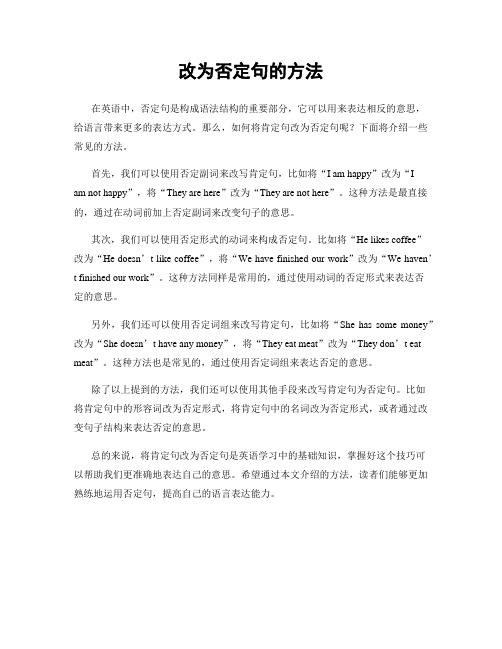
改为否定句的方法
在英语中,否定句是构成语法结构的重要部分,它可以用来表达相反的意思,
给语言带来更多的表达方式。
那么,如何将肯定句改为否定句呢?下面将介绍一些常见的方法。
首先,我们可以使用否定副词来改写肯定句,比如将“I am happy”改为“I
am not happy”,将“They are here”改为“They are not here”。
这种方法是最直接的,通过在动词前加上否定副词来改变句子的意思。
其次,我们可以使用否定形式的动词来构成否定句。
比如将“He likes coffee”
改为“He doesn’t like coffee”,将“We have finished our work”改为“We haven’t finished our work”。
这种方法同样是常用的,通过使用动词的否定形式来表达否
定的意思。
另外,我们还可以使用否定词组来改写肯定句,比如将“She has some money”改为“She doesn’t have any money”,将“They eat meat”改为“They don’t eat meat”。
这种方法也是常见的,通过使用否定词组来表达否定的意思。
除了以上提到的方法,我们还可以使用其他手段来改写肯定句为否定句。
比如
将肯定句中的形容词改为否定形式,将肯定句中的名词改为否定形式,或者通过改变句子结构来表达否定的意思。
总的来说,将肯定句改为否定句是英语学习中的基础知识,掌握好这个技巧可
以帮助我们更准确地表达自己的意思。
希望通过本文介绍的方法,读者们能够更加熟练地运用否定句,提高自己的语言表达能力。
英语肯定句改否定句的方法

肯定句改否定句的发:
1.看句子中有没有系动词或情态动词,如果有,就直接在系动词或情态动词后加not。
例如:They were busy yesterday.(他们昨天很忙),句子中有系动词were,改为否定句时就直接在系动词were 后加not,改为They were not busy yesterday.(他们昨天不忙)。
再例如You should stand here(你应该站在这儿),改为否定句,在情态动词should后加not,改为You should not stand here.(你不应该站在这儿)
2.句子中如果没有系动词或情态动词,就在实意动词前(主语后)don´t或doesn´t 或didn´t(根据实意动词的形态确定),实意动词必须变回原形。
例如:The children feel happy.(孩子们感到快乐),动词是原形形式的feel,所以在动词前加don´t,改为否定句:The children don´t feel happy.(孩子们感到不快乐)
再例如:She takes up the phone(她拿起电话),动词是单三形式的takes,所以在动词前加doesn´t,同时必须把句子中的takes变回原形take,改为否定句:She doesn´t take up the phone(她没拿起电话)
再例如:He told me a story(他给我讲了一个故事),动词是过去式形式的told,所以在动词前加didn´t,同时必须把句子中的told变回原形tell,改为否定句:He didn´t tell me a story(他没有给我故事)。
如何将肯定句改为否定句
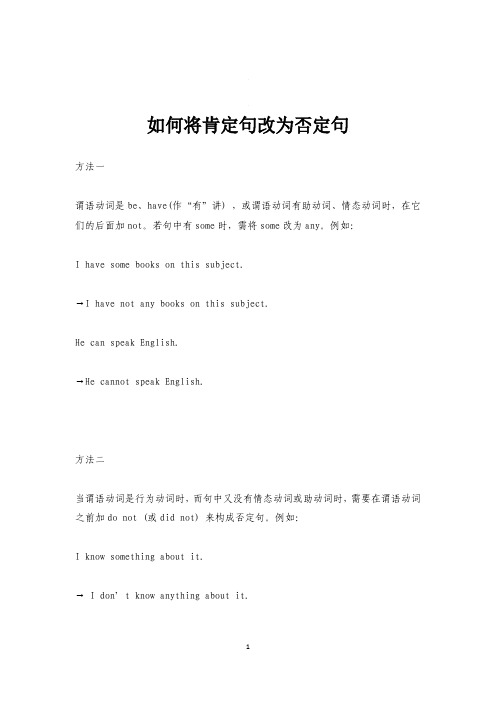
如何将肯定句改为否定句方法一谓语动词是be、have(作“有”讲) ,或谓语动词有助动词、情态动词时,在它们的后面加not。
若句中有some时,需将some改为any。
例如:I have some books on this subject.→I have not any books on this subject.He can speak English.→He cannot speak English.方法二当谓语动词是行为动词时,而句中又没有情态动词或助动词时,需要在谓语动词之前加do not (或did not) 来构成否定句。
例如:I know something about it.→ I don’t know anything about it.方法三否定由think、believe、know等动词引出的宾语从句时,应将主句改为否定形式。
例如:She knows why the train is late.→She doesn’t know why the train is late.方法四祈使句的否定形式是在谓语动词前直接加do not。
例如:Read in bed.→Don’t read in bed.方法五如果肯定句是特殊句型,则要具体问题具体分析:陈述句中含有had better时,变为否定句时,要把not加在better后。
例如:You had better go with me.→You had better not go with me.陈述句中含有both (all) of +名词作主语时,改为否定句时,要用neither 来代替both,none代替all。
并注意谓语动词数的变化。
例如:Both of them are Americans.→Neither of them is American.。
初中英语肯定句变否定句
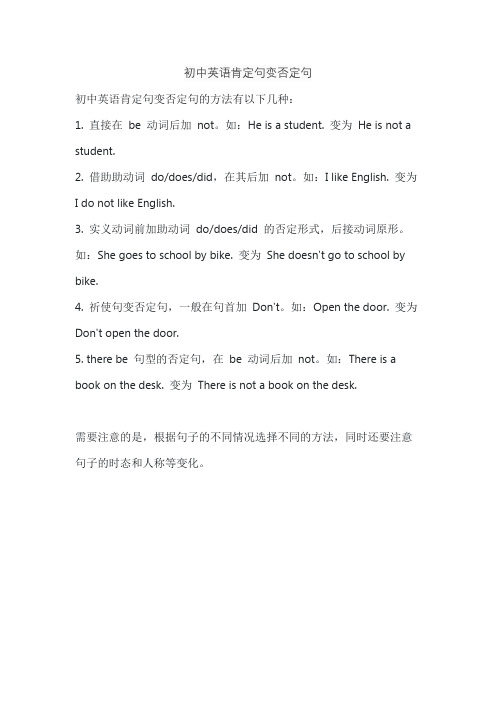
初中英语肯定句变否定句
初中英语肯定句变否定句的方法有以下几种:
1. 直接在be 动词后加not。
如:He is a student. 变为He is not a student.
2. 借助助动词do/does/did,在其后加not。
如:I like English. 变为
I do not like English.
3. 实义动词前加助动词do/does/did 的否定形式,后接动词原形。
如:She goes to school by bike. 变为She doesn't go to school by bike.
4. 祈使句变否定句,一般在句首加Don't。
如:Open the door. 变为Don't open the door.
5. there be 句型的否定句,在be 动词后加not。
如:There is a book on the desk. 变为There is not a book on the desk.
需要注意的是,根据句子的不同情况选择不同的方法,同时还要注意句子的时态和人称等变化。
小学英语肯定句变否定句方法及练习.doc

句型转换的方法(一)一、肯定句改否定句的方法——一步法1、在be动词后加not。
如:is not ,are not ,am not,was not,were not;例如:He is in the classroom. (改为否定句)He is not ( isn’t ) in the classroom.2、在can,should,will等后加not。
如:can not,should not,will not;例如:Mike can sing English songs. ( 改为否定句)Mike can not ( can’t ) sing English songs.3、上述都没有的,在动词前加助动词否定形式don’t/doesn’t/didn’t。
例如:I like pizza. ( 改为否定句)I don’t like pizza.4、句中有some 的要改成any。
例如:There are some books on the desk. ( 改为否定句)There are not ( aren’t ) any books on the desk.二.实战演习: 把下列各句改为否定句1.John is walking in the park.__________________________________2.Tom and Marry are friends.___________________________________3.I’m a student.___________________________________4.She will go to Beijing tomorrow,___________________________________5.We get there by bike.___________________________________6.He likes apples.___________________________________7.There are some flowers in the picture.__________________________________8.I often play football with my friend.__________________________________9.We are from China.__________________________________10.They can go to school by ferry._________________________________赠送以下资料考试知识点技巧大全一、考试中途应饮葡萄糖水大脑是记忆的场所,脑中有数亿个神经细胞在不停地进行着繁重的活动,大脑细胞活动需要大量能量。
- 1、下载文档前请自行甄别文档内容的完整性,平台不提供额外的编辑、内容补充、找答案等附加服务。
- 2、"仅部分预览"的文档,不可在线预览部分如存在完整性等问题,可反馈申请退款(可完整预览的文档不适用该条件!)。
- 3、如文档侵犯您的权益,请联系客服反馈,我们会尽快为您处理(人工客服工作时间:9:00-18:30)。
肯定句变否定句的基本方法一、动词be 的否定式动词be根据不同的人称和时态可以有am, is, are, was, were等不同形式,可用作连系动词(表示“是”、“在”等)和助动词(用于构成进行时态和被动语态等),但不管何种情况,构成否定式时,一律在其后加notI’m old, but you’re young. 我老了,但你还年轻。
→I’m not old, but you’re not young. 我还不老,但你不年轻了。
He was reading and I was writing. 他在读,我在写。
→He was not reading and I was not writing. 他没有在读,我没有在写。
二、动词have 的否定式动词have根据不同的人称和时态可以有have, has, had等形式,可以用作实意动词和助动词,分以下情况讨论1. 用作实意动词表示状态,如表示拥有、患病或用于have to表示“必须”等,在构成否定式时可以直接在其后加not,也可根据情况在其前使用don’t, doesn’t, didn’tHe has a car. 他有辆小汽车。
→He hasn’t a car. / He doesn’t have a car. 他没有小汽车。
He had some dictionaries. 他有一些词典。
→He hadn’t any dictionaries. / He didn’t have any dictionaries. 他没有词典。
You have to go with him. 你必须同他一起去。
→You haven’t to go with him. / You don’t have to go w ith him. 你不必同他一起去。
【注】have to构成否定式时以在其前加don’t等较为常见。
2. 用作实意动词表示动作,如表示“吃(=eat)”、“喝(=drink)”、“拿(=take)”、“收到(=receive)”、“度过(=spend)”等,构成否定式时不能直接在其后加not,而应根据情况在其前使用don’t, doesn’t, didn’tHe had some cake for breakfast. 他早餐吃了些蛋糕。
→He didn’t have any cake for br eakfast. 他早餐没有吃蛋糕。
(不能用had not)We had a good holiday. 我们的假期过得很愉快。
→We didn’t have a good holiday. 我们的假期过得不愉快。
(不能用had not)3. 用作助动词构成完成时态,其否定式只能在其后加notI have read the book. 我读这本书。
→I have not read the book. 我还没读这本书。
He had left when I arrived. 我到达时他已离开了。
→He hadn’t left when I arrived. 我到达时他还没有离开。
三、情态动词的否定式情态动词的否定式一般在其后加not构成I can finish the work in an hour. 我能在1小时内完成这工作。
→I can’t finish the work in an hour. 我不能在1小时内完成这工作。
You must go with us. 你必须同我们一起去。
→You mustn’t go with us. 你不能同我们一起去。
We should help them. 我们应该帮助他们。
→We shouldn’t help them. 我们不必帮助他们。
四、实意动词的否定式一般实意动词的否定式,通常应根据不同时态和人称在实意动词之前加don’t, doesn’t, didn’t等He works in a bank. 他在一家银行工作。
→He doesn’t work in a bank. 他不是在银行工作。
We often hear from her. 我们经常收到她的来信。
→We don’t often hear from her.我们不经常收到她的来信。
I met her at the station. 我在车站见到了她。
→I didn’t meet her at the station. 我在车站没见到她。
●要注意加上does not或did not改为否定句以后,要把原句的动词改为原形动词,特别是行为动词do的第三人称单数does和过去时did,在主语后面加上doesn't或didn't以后,千万要注意把句中的does或did改为do。
五、祈使句的否定结构为:don't十原形动词。
改为否定句时,要在句首加上don't,其它不变,即:Look out of the window.→Don't look out of the window.六、当陈述句中含有something这个词时,把句子改为否定句有两种方法:其一,在句中相应位置加not,再把something改成anything;其二,直接把something改为nothing即可。
例.There is something wrong with the radio.把这个句子改为否定句有两种方法:其一,先把not加在is后面,再把something改为anything 即:There is not anything wrong with the radio.其二把something直接改为nothing,即:There is nothing wrong with the radio.例.I have something important to tell you .把这个句子变成否定句有两种方法:其中一种方法是先把not加在have后面,再把something 变成anything,即:I have not anything important to tell you.第二种方法是直接把something 改为nothing,即:I have nothing important to tell you.七、当陈述句是一个主从复合句,而主句的谓语动词是think或believe等时,把这种句子改为否定句,往往是否定think或believe等而不否定后面从句中的谓语动词,尽管意思是否定从句的谓语动词。
例.I think he will be back soon.这个复合句中主句的谓语动词是think,所以在改为否定句时要在think前面加上don't,即:I don't think he will be back soon.汉语意思:我认为他不会很快回来。
八、某些特殊句型改为否定句时,有不同的方法:1)在陈述句中含有had better时,要把not加在better后面,动词原形前面。
例.You had better go with us.把这个句子改为否定句,要把not加在better之后,g o之前,即:You had better not go with us.千万不要改成:You had not better to go with us.或You had better don't go with us.因为,要否定的是后面的动词不定式短语。
同时,had better后面要用动词原形(不带to)。
2)当陈述句中含有both+名词或者both of+名词作主语时,改为否定句时则用neither代替both,并且要注意谓语动词数的变化。
例.Both of them work in the school library.句子含有both,改为否定句时用neither代替both,同时谓语动词work改为works,即:Neither of them works in the school library.例.Both answers are right.把这个句子改为否定句,用neither代替both,谓语动词are改为is,即:Neither answer is right.3)句中含有both...and的肯定句改为否定句时用neither ...nor改写,同时neither...nor 还可以把两个简单句的否定形式连成一个句子。
例.Both Mary and Joan are students.把这个句子改为否定句时,通常用Neither...nor代替Both...and,同时把are改为is,students 改为a student即:Neither Mary nor Joan is a student.●neither...nor连接两个主语时,谓语动词决定于nor后面的名词或代词的单复数形式。
例.This book is both interesting and instructive.把这个句子改为否定句,用neither...nor代替both...and,因为连接部分在句中作表语,所以谓语动词不变,即:This book is neither interesting nor instructive.例.I don't see that film.He doesn't see it either.这两个否定句可以用neither...nor连成一个句子,谓语动词改为肯定式see,人称和数由nor后面的he决定,即:Neither he nor I see that film .,或者把I和he交换.即:Neither I nor he sees that film.这说明谓语的人称和数由nor后面的靠近谓语的人称和数决定。
在把肯定句改为否定句时,注意把句中的some,already,something等词改为any,yet,anything。
有一些表示否定意义的副词,如never,seldom ,hardly ,little ,few等也可以使句子成为否定句。
例如:He has few good friends here.There is little water in the bottle.I hardly believe it.巩固练习:将下列句子改为否定句1.We do morning exercises every day.We _______ _______ morning exercises every day.2.All of us can swim._______ _______ _______ can swim._______ Joan _______ I _______ in Class One.4.There is something wrong with my bike.There _______ _______ wrong with my bike.5.You may stay here before I come back.You _______ _______ here before I come back.6.Read the text after me._______ _______ the text after me.7.Li Lei needs some help with his English.Li Lei _______ _______ _______ help with his English.8.He said he would g o to Beijing the next week.He _______ _______ _______ _______ go to Beijing the next week.9.The bike has already been m ended.The bike _______ _______ mended _______ .10.I think it is going to rain tomorrow.I _______ _______ _______ _______ going to rain tomorrow.Key:1.don't do 2.None of us 3.Neither;nor;am 4.is nothing 5.mustn't stay 6.Don't read 7.doesn't need any 8.didn't say he would 9.hasn't been;yet 10.don't think it is。
